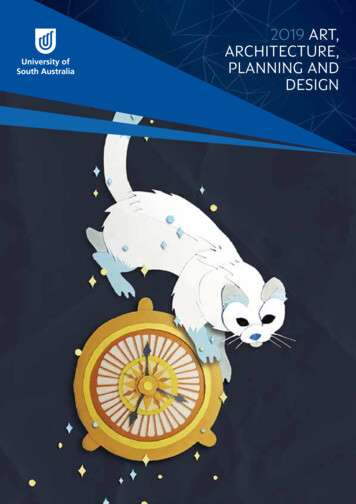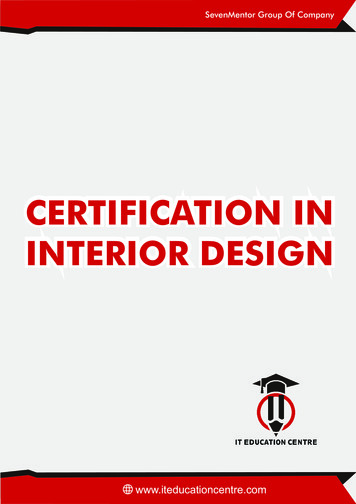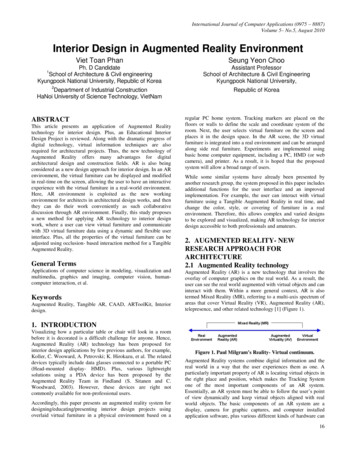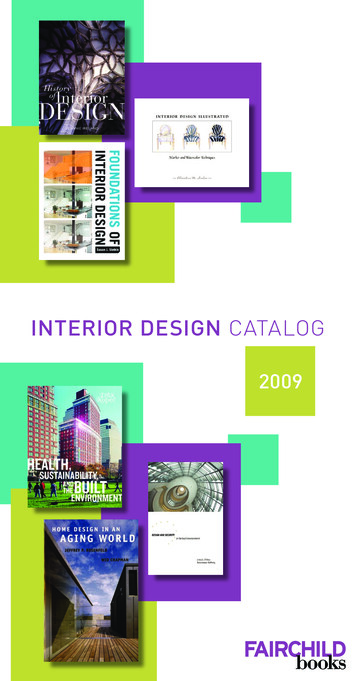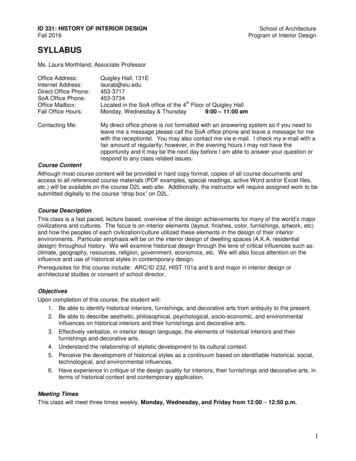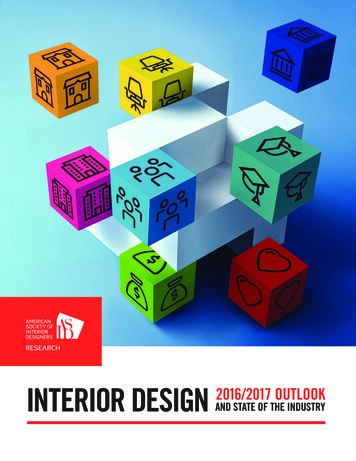
Transcription
Interior Design/Interior Architecture Educators AssociationIDEA Journal 2004
iiii
CharterIDEA was formed to encourage and support excellence in Interior Design/Interior Architecture education and researchand be the regional authority on, and advocate for, Interior Design/Interior Architecture education and research.ObjectivesThe objectives of IDEA are to: act as an advocate for interior design/interior architecture undergraduate and postgraduate degree programs; support the diversity of degree programs; provide recognition for excellence through refereed citations awarded to academic staff of the above programs; publish and disseminate results of research and refereed work carried out in member Institutions; foster and encourage collaboration within and beyond the membership of IDEA; foster an attitude of lifelong learning; and encourage academic exchange within the membership of IDEA.www.idea-edu.cominfo@idea-edu.comMember InstitutionsMembership is open to institutions offering interior design or interior architecture undergraduate degree programs offour years duration (except in extraordinary circumstances approved by the Association when the program may be ofthree years duration).Curtin University, Perth, AustraliaMassey University, Wellington, New ZealandMonash University, Victoria, AustraliaQueensland University of Technology, Queensland, AustraliaRMIT University, Victoria, AustraliaUniversity of New South Wales, New South Wales, AustraliaUniversity of South Australia, South Australia, AustraliaUniversity of Technology, Auckland, New ZealandUniversity of Technology, Sydney, New South Wales, AustraliaVictoria University, Wellington, New ZealandWellington Institute of Technology, Wellington, New ZealandIDEA Journal 2004 IDEA, 2004Published atQueensland Univeristy of TechnologyBrisbane, AustraliaRegistered at the National Library of Australia. ISSN 1445/5412iii
Refereeing ProcessEach IDEA member university is asked to publicise the scheme and encourage submissions from its academic staff andpost graduate students. Expressions of interest are called for and an abstract outlining title and a concise summaryof the project or paper is required in the first instance. Following receipt of the completed paper, the Editorial Chairarranges for its anonymous assessment by three referees. Referees are selected for their acknowledged expertise in thematter to be refereed.IDEA has adopted a double-blind refereeing process. The anonymity of author and referee are maintained at all times.The referees are asked to submit confidential reports directly to the Chair by a required date. The Editorial Committeeaccepts for publishing the submissions that receive majority support from referees.The decision of the IDEA committee is final, with no correspondence entered into regarding the awarded status of thesubmissions. Referees’ reports are made available to applicants upon request, within one month of the submissionsbeing chosen for publication.Criteria for SelectionSubmissions will be accepted based on the following criteria.1. The work contributes to the body of knowledge that is the basis of interior design/interior architecture.2. The intentions are well articulated and their achievement is substantiated through intellectual and academic rigour.3. Outcomes are identified and there is evidence of scholarly reflection on their significance.4. The work has not been previously published or is in the process of being refereed for another publication.Editorial CommitteeDr Jill Franz (Co-editor)Dr Dianne Smith (Co-editor)BAppSc(BltEnv), DipT, MEdStud, PhD, MDIABSc, BArch(Hons), Grad Dip Int Des(Dist),(Accredited Designer)GradCertEd(HigherEd), PhD, MDIA, RAIAGill Matthewson (Chair IDEA)BArch, MA(Arch)CopyAll copies remain the intellectual property of each university and individual artist/author concerned. Reproduction isprohibited without written permission of the publisher.Previous PublicationsIDEA 1999IDEA 2001IDEA 2002IDEA 2003Correspondence regarding this publication should be addressed to:IDEAInterior Design, School of DesignQueensland University of TechnologyGPO Box 2434 Brisbane Q 4001 AustraliaFacsimilie 61 7 3864 1528iv
RefereesDr Barbara Adkins, Queensland University of TechnologyEmiritus Professor Helen Armstrong, Queensland University of TechnologyCida de Aragon, Graphic Design MADr Laurie Buys, Queensland University of TechnologyAngela Blakely, Queensland University of Technology and Queensland College of ArtDr Philip Crowther, Queensland University of TechnologyJoanne Cys, University of South AustraliaKatina Dimoulius, Sydney UniversityDr Nur Demirbilek, Queensland University of TechnologyPeter Hedley, Queensland University of TechnologyRachel Hurst, University of South AustraliaAssociate Professor Brad Haseman, Queensland University of TechnologyProfessor Michael Kenniger, University of QueenslandDr Anoma Kumarasuriyar, Queensland University of TechnologyJane Lawrence, University of South AustraliaDavid Lloyd, Queensland College of Art, Griffith UniversityDr Catriona McLeod, University of TasmaniaBill McKay, UNITEC, New ZealandFiona Martin, Queensland University of TechnologyPriya Metcalfe, Curtin UniversityAssociate Professor Andrea Mina, RMIT UniversityDr Antony Moulis, University of QueenslandJudith O’Callaghan, University of New South WalesRobyn Peacock-Smith, Queensland College of Art, Griffith UniversityAssociate Professor Vesna Popovic, Queensland University of TechnologyJulieanna Preston, Massey University, New ZealandPaul Sanders, Queensland University of TechnologyAssociate Professor Susan Savage, Queensland University of TechnologyNicola Stairmand, Historic Interiors ConsultantHarry Stephens, University of New South WalesDr Susan Stewart, University of Technology SydneyDr Malgosia Zlobicki, Queensland University of TechnologyVeronica Garcia Hansen, Queensland University of TechnologyGeorge Verghese, University of Technology SydneyDisclaimerTo the extent legally permissible, the editors, authors and publishers exclude or disclaim all and any liability (includingliability arising in contract and tort) to any person, whether or not through this publication, for any loss howsoeverarising and whether or not caused by the negligence of any of the editors, authors and publishers resulting fromanything done or omitted to be done in reliance, either whole or partial, upon the contents of this publication.v
vivi
ContentsTowards an Interior HistorySuzie Attiwill1Side-by-side: A Pedagogical Basis for (Design) TransdisciplinarityAssocciate Professor Jill Franz and Professor Steffen Lehmann9Cooperative Learning in an Interior Architecture StudioJo Dane31Architecture of Alienation: The Double Bind and Public SpaceAssociate Professor Dorita Hannah43The SICO Color Naming Project: Forging Ties Between Educatorsand IndustryDr Tiiu Poldma and Hans Samuelson59Visual and Textual interfaces in Design Research: Considering the Valueof Concept maps as an Interior Design Research ToolDr Tiiu Poldma and Dr Mary Stewart71Re-discovering the Creative Collage in the Architectural RepresentationSeungkoo Jo81inside-out: speculating on the interiorCathy Smith93COLOUR and SPACE: An Investigation of Three-DimensionalityDr Dianne Smith103vii
viii
Towards an Interior HistorySuzie Attiwill, RMIT University, AustraliaAbstract: An interior history as a concept brings together history and interior design witha particular emphasis on addressing the spatial and temporal qualities that are implicitin both practices. Titled ‘Towards an Interior History’, this paper focuses on a process ofmaking, hence the word ‘towards’ an interior history. It is not yet in a position to definewhat an interior history is – to answer the question ‘what is an interior history?’ – and maynever be. By the end of the paper, it is hoped that questions such as ‘How does an interiorhistory work?’ ‘How does it function?’ will be understood as more useful to pose. Why?Because dominant models of history and interior design have produced particular kinds ofhistories of interior design – ones which privilege the visual, hence objects and permanentarchitectural elements, as well as structures of enclosure and containment. An interior historyas a concept celebrates the role of history in the production of the new and seeks to respondto current forces emerging in the design of interiors – for example, temporality, movement,change, encounters. The position here is not one of criticism and a quest for a better history,an attempt to re-write the past in order to re-right. The term ‘inter-story’ – formed from aconjunction between interior and history – is introduced as a technique for re-thinking historyand interior design and as an approach to be taken up in a movement towards an interiorhistory in the making of an interior history.Keywords: interior, history, inter-storyIntroductionAn interior history is, at this stage, a concept that is in the process of taking shape. Theprocess involves questioning the history of interior design and rethinking the disciplines ofhistory and interior design with a particular emphasis on addressing the spatial and temporalqualities that are implicit in both practices. In the conjunction between interior and historydifferent possibilities emerge leading to an interior history. Titled ‘Towards an interior history’,this paper presents the making of this concept. It will not attempt to exemplify what thisconcept produces so much as open up the possibility of thinking differently, and providesome tools and techniques by collecting together ideas and methods useful in its making.In this sense, this paper is ‘a box of tools’. This analogy is taken from the writings of thephilosopher Gilles Deleuze. He goes on to say that: ‘It must be useful. It must function. Andnot for itself. If no one uses it, beginning with the theoretician himself (who then ceases tobe a theoretician) then the theory is worthless or the moment is inappropriate’ (Deleuze &Foucault, 1972, p. 208).1
While the concept of history is not only acknowledged but also celebrated as a participantin the making of the new and assisting processes of emergence, the paper also argues fora rethinking of history, as constant variation, if it is to engage with the kinds of interiorsthat are emerging. Structures of categorisation and a privileging of the visual in relation toknowledge have produced histories of interior design, which are histories of objects andstatic form such as interior architecture, decoration and/or furniture. It is worth observing theshared dominant structures of both history and interior design: containers and enclosures, bethey boxes of categories or boxes of architecture.The position taken up here is not one of criticism and a posing of a better history, whichre-writes to re-right. Instead it is an investigation in the possibility of writing a history ofinteriors that does not necessarily involve processes of enclosure. It is about reorientingand shifting dominant models to find a useful method to make a history that responds toemerging aspects of interior design that currently do not find a lineage in any of the existinghistories and, in the process, produce a platform for new work and ideas. This platform,once made, will offer interior design students a diagram composed of multiple connections,spatialities and temporalities. It will then operate alongside existing histories organised aroundspatial concept of enclosure and fixed categories such as modernism and postmodernism,and temporal concepts of linearity such as past, present and future.The research for this proposition draws on a number of philosophers’ writings includingMichel Foucault, Brian Massumi, Elizabeth Grosz and John Rajchman. The thread that linksthem together and invites them into this paper is Gilles Deleuze. The connection to their workis not one of referencing to add substance to a position nor as an example of precedence buta connection of usefulness – their writings have stimulated these ideas and offered directionsthat have been useful to the rethinking of an interior history. Their philosophies address andopen up notions of both history and interiors.The motivation for this research finds expression in the subtle yet startling shift of emphasisexpressed by Foucault in Discipline and Punish when he considers his reasons for writinghistory: ‘Why? Simply because I am interested in the past? No, if one means by that writinga history of the past in terms of the present. Yes, if one means writing the history of thepresent’ (Foucault, 1997, p. 31). Foucault makes apparent spatial distributions and temporalevents as composing forces. Massumi’s ‘productionist approach’ is another tool in this box– an approach that challenges the disciplines of the humanities, including history, in termsof the privileging of critical thinking to advocate instead an active relation of invention andaffirmation to knowledge. Grosz and Rajchman – bring the temporal to the surface of their2
focus. From their texts, I have picked up attitudes and styles, techniques and methods. Allof these have been adapted and fashioned to become tools for the making of an interiorhistory that seeks to pursue the directions offered up as well as take up the lines of potentialexpressed in students’ projects.Interior design and historyThe use of the term ‘interior design’ is deliberate and not interchangeable with interiorarchitecture. A distinction is made here to indicate that the design of interiors is not tobe limited to inside built form. This is vital to the ability to apprehend emerging forces.Fixed architectural enclosures are no longer the dominant shaping and mediating elementfor interior and exterior relations, for example – the change in the work environment.An office was once defined by a building – an office building. Now a building may havedifferent functions at different times, sometimes an office, other times a home. An officethen becomes a temporal and spatial occurrence involving a reorganising of relations – forexample, from domestic to office environment. Another example is disciplinary confinementwhere it is no longer necessarily a physical enclosure such as a prison but may be asurveillance network that operates on a global positioning system. The question of interiorand exterior are still pertinent and potent but they are dynamic, changing relations ratherthan one of permanence defined by built form. Interior design then becomes an activity oforganising material spatially and temporally.Similarly, the term ‘history’ is useful to tease out and question dominant and dominatingstructures. Mitchell Dean writes in his book, Critical and Effective Histories. Foucault’s methodand historical sociology: ‘For no matter how much historical writing is about dimensions oraspects of the past, and refer to events, irruptions, discourses, and social practices that canbe given a particular time-space, it is in fact an activity that is irrevocably linked in its currentuses. One way of getting at this idea of history, as a practice within a definite present is tonote that certain kinds of history arise from the rather simple necessity of having to deal withthe records of one sort or another produced within and across the boundaries of nationalsocieties. This is not simply a repetition of the idea that all histories are written from aparticular viewpoint or perspective, because it is also concerned to come to terms with historyas a practice, as a particular set on actions brought to bear on a particular material (Dean,1994, pp. 14–15).I have italicised the words ‘activity’, ‘uses’ ‘practice’ and the phrase ‘a particular set ofactions on a particular material’ to draw focus to design qualities implicit in this kind ofattitude to history. Both design and history involve processes of ordering. Approached in3
this way, history is understood as an activity involving a process of selection, collection andarrangement to construct an encounter with material and produce meaning. Museums area wonderful example of three-dimensional histories in this sense – where visitors encounterhistory through processes of collection, organisation, arrangement and juxtaposition. They arespatial, temporal and material constructions that locate and energise objects and subjects toproduce knowledge in relation.This highlights a relation to history where the making of history is made apparent. In museums,for example, this involves a shift from displaying the object as the thing to be known and thesubject as the knower to the event of encounter as the space where knowledge is produced(Whitehead, 1933, pp. 204–205). Massumi’s concept of a ‘productionist approach’ whereknowledge is produced and inventive, in contrast to knowledge as critique and interpretation,expresses a similar orientation (Massumi, 2002, p. 13).While Massumi does not specifically address design or history in this context, his use ofconcepts of production and invention are qualities which connect to design thinking,especially in relation to the projective nature of design activity. As with Foucault, we arepresented with the potential of history as a material practice involving actions and techniquesin the production of what can be known. This approach is taken up in this paper as a vitalingredient in re-orienting history; to project, add and experiment in the making of an interiorhistory. To pause then to consider existing histories of interior design which actualise aparticular set of circumstances.Existing histories of interior designHistories of art, architecture and interior design are strikingly similar in structure and methodsof organisation. They are chronological accounts that privilege the visual and hence focusprimarily on objects (which are able to be collected and categorised) and the process ofcontaining (in systems of taxonomies and physically, in museums). It is the dominant model.The words of prominent Australian art historian Bernard Smith, for example, could also beapplied to existing histories of interior design: ‘ classification in art history is primarily visualclassification. That is why, in my view, art history is grounded epistemologically in the conceptof style, and visual style at that. style addresses artefacts in their visuality, bringing orderto that visuality. Nor is visual style an essential tool only to art history. It is essential also toarchaeology for example’ (Smith, 2000, pp. 6–7). It is interesting to note that Smith wrotethis in a text titled In Defence of Art History which was a response to a series of papers onthe challenges facing art history by practices, such as performance art, which do not privilegevisual form.4
Studying interior design in the early nineties, I found it curious that the history we wereexposed to as students focused entirely on objects, mainly furniture and this contrasted towhat we were engaged with in our design studios – spatial explorations. This history was alsolinear – beginning with Egyptian head stools and ending with postmodernism, which wasaddressed as a visual style of historical pastiche. It was apparent that this history was not ableto incorporate the concept of spatiality. I was intrigued why interior design history did notrespond to what was happening within its discipline and practice.Histories of interior design are sparse on library and bookshops shelves. Those that existfollow the dominant model of history outlined above. John Pile’s A History of Interior Designis a recent text and one of few texts dedicated to interior design yet it is a classical historytext in that it demonstrates a linear chronological and stylistic model of history. MichaelBogle’s Designing Australia. Readings in the History of Design is interesting as a collectionof essays because the collection exposes what can be said and thought under such a title inthe year 2002 in Australia. Under the heading of ‘Interior Design’ are four essays and eachconcerns decoration, domesticity and the home. A Philosophy of Interior Design by StanleyAbercrombie deals with the inside of architecture and breaks the interior into thresholds ofinside/outside as defined by an architectural enclosure, for example doors, windows. TheInterior Dimension. A Theoretical Approach to Enclosed Space by Joy Monice Malnar isanother significant text, which attempts to position interior design – and as indicated in thetitle, interior is equated with enclosure.In all of the above, interior design and history, and therefore the history of interior design– focus on objects and enclosure where the visual and static built form is privileged. Myposition is not one that dismisses these histories so much as highlight how they are shaped isdue to the nature of their box of tools and this produces structures and systems. I am curiousas to the potential of other ways of thinking and doing – of taking up a different attitude.Interior design – current forcesThe condition of interior and interiority is generally conceived of as one of frames andenclosures – a container condition which is static, defined by boundary conditions and apre-existing void to be filled. Different mobilities and technologies however are transformingboundaries and incite new possibilities. The relation between interior and exterior becomesdynamic and multiple, constantly changing and inverting. In final year RMIT interior designstudent thesis projects one can see the effect of these forces and shifts to concerns withmobility and the transient, to interstitial spaces in the production of interiors.5
The temporal – how space is inhabited – is a vital force in these designs. ‘The emergingdiscipline of interior design is differentiated from interior decoration or architecture by itsbeing a discipline of spatial performance and experience rather than one of composition orstyle’ (Pringle, 2001). In many ways, temporality is emerging as a defining element of currentpractice. From an interior design position, this offers much to consider and rather thaninterior as always already inside something – inside a container – it suggests an interior asproduced through the spatialisation of matter by time: an event.Elizabeth Grosz writes of the temporal in relation to architecture and while she does notspecifically mention interior design, her question ‘How can we understand space differently,in order to organise, inhabit, and structure our living arrangements differently?’ addresses aninterior condition. She goes on to suggest that answers lie in the ‘direction of time, duration,or temporal flow, which is usually conceptualised as the other, the outside, or the counterpartto space. [Her] central argument throughout is that architecture, geography, and urbanplanning have tended to neglect or ignore temporality or to reduce it to the measurable andthe calculable, that is, to space. It is central to the future of architecture that the question oftime, change and emergence become more integral to the process of design and construction(Grosz, 2001, p. xix).Interior design histories have also ignored temporality in the design of interiors through a focuson objects and built space as static form. Or perhaps, it is due to an aspiration to equate interiordesign with architecture. Grosz’s writing, together with the other references made here, suggest– and advocate – a shift that is rich with possibilities and offers incentive to directions alreadybeing explored and experimented with through the discipline of interior design.Inter-story – an attitudeIn an article on the question of what’s new in architecture with reference to Foucault andJacques Derrida, John Rajchman makes a poignant observation that ‘the spaces we inhabitare always events that cannot be ever quite exhausted by the meanings with which we investthem’ (Rajchman, 1991, p. 153).The concept of ‘inter-story’ is introduced here as a way to apprehend and incorporate thetemporal as a composing force in the design of interiors. It plays on a combination of thewords ‘interior’ and ‘history’ – becoming inter- and -story. To enter between them: outsidethe enclosures of both; in the encounter between them. It is posed as a place and attitude formaking an interior history. The interior as a concept of enclosure is intervened and opened– becoming a dynamic spatial and temporal condition between things where interiors andexteriors are in constant production.6
The interrupting of history as a strategy to destabilise models, assumptions and givens ofboth history and interior design is the main driving force. Inter-story gestures towards adifferent order from a linear or dialectical one, and enters between. Stories that are ‘inter’,both spatially and temporally, that interrupt dominant narratives, interfere with models, andintervene to dislocate plans, as ‘a way of spacing that gives its place to the event’ (Rajchman,1991, p. 157). In contrast to history as a processing of enclosing and fixing, it becomes aquestion of building a platform for arrivals and departures where the emphasis is not onfinding and fixing meaning but on making sense, on producing and inventing. A writing ofinterior design as a history of temporal inter-faces with space shifts the focus from a historyof static objects and built form to, both, history and interiors as dynamic productions in theinhabitation of space.‘History is the archive, the drawing of what we are and what we are ceasing to be, whilstthe current is the sketch of what we are becoming’ (Deleuze, 1992, p. 164). A drawing of‘what we are and what we are ceasing to be’ – it is these tangled lines and a process ofdrawing them out which provide conjunctions for creativity. Inter-story engages these spatialand temporal relations to consider differently other ways of drawing, producing maps andexperimentations, diagrams of orientation and stylistic stances where movement, change,and temporality produce interiors and exteriors. What kinds of inter-stories will perform thisinterior history? The sketch has been done here – if ever so lightly – in a process of becoming.ReferencesAbercrombie, S. (1990). A Philosophy of Interior Design. New York: Harper & Row.Bogle, M. (Ed.). (2002). Designing Australia. Readings in the History of Design. Australia:Pluto Press.Dean, M. (1994). Critical and Effective Histories. Foucault’s Methods and Historical Sociology.London & New York: Routledge.Deleuze, G. (1992). What is a dispositive? In Armstrong, T. (Ed.). Armstrong, T. (Trans.), MichelFoucault Philosopher. Hertfordshire: Harvester Wheatsheaf.Deleuze, G., & M. Foucault. (1972). Intellectuals and Power. A conversation between MichelFoucault and Gilles Deleuze. In Bouchard, D. F. (Ed.), (1977). Language, Counter-Memory,Practice. Selected Essays and Interviews by Michel Foucault. Ithaca: Cornell University Press.Foucault, M. (1977). Discipline and Punish. The Birth of the Prison. Great Britain: PeregrineBooks.Grosz, E. (2001). Architecture from the Outside. Essays on Virtual and Real Space. WritingArchitecture Series, Massachusetts: Massachusetts Institute of Technology.Massumi, B. (2002). Parables for the virtual. Movement, Affect, Sensation. Durham &London: Duke University Press.7
Malnar, J. M. (1992). The Interior Dimension. A Theoretical Approach to Enclosed Space. NewYork: Van Nostrand Reinhold.Pile. J, (2000). A History of Interior Design. London: Laurence King Publishing.Pringle, P. (2001). Quote taken from Doctorate Review of Candidature presentation, October2001, School of Architecture and Design, RMIT University.Rajchman, J. (1991). What’s new in Architecture? Philosophical Events. Essays of the ‘80s.New York: Columbia University Press.Smith, B. (2000). In defence of art history. Art Monthly, July, 131.Whitehead, A, N. (1933). Adventures of Ideas. Great Britain: Penguin Books.Acknowledgements:The word ‘inter-story’ came about in a conversation with Tom Loveday in December 2002. Itevolved from the term ‘inter-space’ which was the focus of a paper titled ‘an interior history’ Ipresented at Mind the Map. The Third International Conference on Design History and DesignStudies Istanbul, Turkey, July 2002. For ‘inter-space’, I would like to acknowledge NormanDavis’s contribution to my research project.8
Side-by-side: A Pedagogical Basis for (Design)TransdisciplinarityAssociate Professor Jill Franz and Professor Steffen Lehmann, QueenslandUniversity of Technology, AustraliaAbstract: In this paper, a pedagogical model for fostering transdisciplinarity in the builtenvironment is described. Unlike learning situations in design education which usemultidisciplinary teams, this model is characterised by students working side-by-side on thesame project each producing their own proposal. As is explained, the development of thismodel was inspired by a growing awareness of the need to look beyond discipline boundariesin order to more effectively address issues involving the design of the built environment;issues associated with a rapidly changing and increasingly technologically complex world.In this respect, transdisciplinarity formed the philosophical and theoretical basis for thedevelopment and implementation of a cross-discipline studio elective for architecture andinterior design students from years three to six in their course. While there are limitationswith the model, the evaluation reveals insights into how we might continue with constructingmore appropriate learning opportunities for engendering transdisciplinary attitudes instudents and graduates.Keywords: architecture; interior design; cross-disciplinarity; transdisciplinarityIntroductionThis paper describes the development, implementation and evaluation of a design studioelective by the authors Professor Steffen Lehmann (Coordinator of Architecture) andAssociate Professor Jill Franz (Coordinator of Interior Design). Unlike cross-disciplinary studiosthat involve students from
An interior history is, at this stage, a concept that is in the process of taking shape. The process involves questioning the history of interior design and rethinking the disciplines of history and interior design with a particular emphasis on addressing the spatial and temporal qualities that are implicit in both practices.

